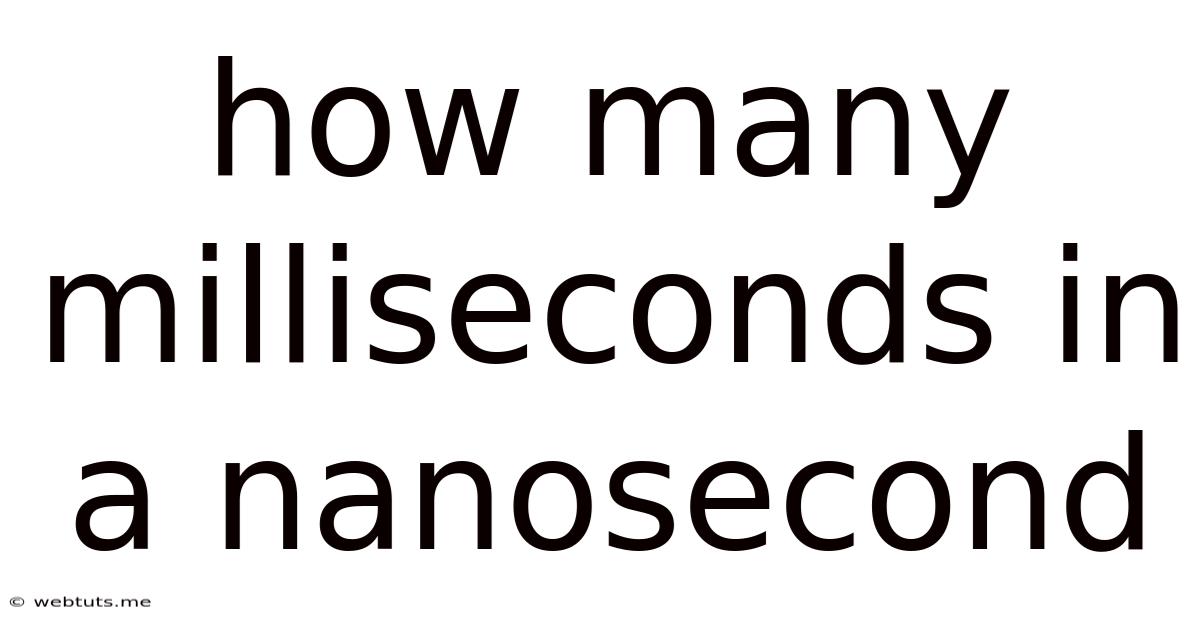How Many Milliseconds In A Nanosecond
Webtuts
May 10, 2025 · 4 min read

Table of Contents
How Many Milliseconds are in a Nanosecond? Understanding Time Units
Understanding the relationship between different units of time is crucial in various fields, from computer science and engineering to physics and finance. This article delves deep into the conversion between milliseconds and nanoseconds, explaining the concepts clearly and providing practical examples. We'll explore the prefixes used in the metric system, show you how to perform the conversion, and illustrate its importance in various applications.
Understanding Prefixes in the Metric System
The metric system, also known as the International System of Units (SI), is based on powers of 10. This makes conversions between units remarkably straightforward. When dealing with time, we frequently encounter prefixes like "milli," "micro," and "nano," which represent fractions of a second. Let's break them down:
- Second (s): The base unit of time.
- Millisecond (ms): One-thousandth of a second (1 ms = 10⁻³ s = 1/1000 s)
- Microsecond (µs): One-millionth of a second (1 µs = 10⁻⁶ s = 1/1,000,000 s)
- Nanosecond (ns): One-billionth of a second (1 ns = 10⁻⁹ s = 1/1,000,000,000 s)
- Picosecond (ps): One-trillionth of a second (1 ps = 10⁻¹² s = 1/1,000,000,000,000 s)
These prefixes systematically represent decreasing magnitudes of time, each a factor of 1000 smaller than the previous one. This consistent scaling makes conversions within the metric system relatively simple.
The Conversion: Milliseconds to Nanoseconds
The core question is: How many milliseconds are in a nanosecond? The answer isn't a whole number; instead, it's a very small fraction. To understand this, let's visualize the relationship:
A millisecond is 1000 times larger than a microsecond, and a microsecond is 1000 times larger than a nanosecond. Therefore, a millisecond is 1,000,000 (1000 x 1000) times larger than a nanosecond. Conversely, there are 1,000,000 nanoseconds in one millisecond.
We can express this mathematically as follows:
1 ms = 1,000,000 ns
Or, to put it another way:
1 ns = 0.000001 ms
This means that a nanosecond is one-millionth of a millisecond. This tiny fraction highlights the significant difference in scale between these two units of time.
Practical Applications and Examples
The distinction between milliseconds and nanoseconds is vital in several contexts:
1. Computer Science and Engineering
-
Processor Speed: Modern processors operate at speeds measured in gigahertz (GHz), meaning billions of cycles per second. Individual instructions can take multiple nanoseconds to execute. Understanding nanosecond-level timing is critical for optimizing software and hardware performance. The latency of memory access, for instance, is often measured in nanoseconds.
-
Network Communication: Network latency, the delay in transmitting data across a network, is often measured in milliseconds. However, advancements in high-speed networking are pushing the boundaries into the microsecond and even nanosecond range.
-
Data Storage: Access times for solid-state drives (SSDs) and other fast storage technologies are measured in microseconds or even nanoseconds, significantly faster than traditional hard disk drives (HDDs) which operate in milliseconds.
2. Physics
-
Light Travel: Light travels approximately 30 centimeters (about 1 foot) in one nanosecond. This incredibly short distance emphasizes the brevity of a nanosecond. This fact is crucial in high-speed optical communication and measurements.
-
Chemical Reactions: Many chemical reactions occur on timescales measured in nanoseconds or even picoseconds. Understanding these incredibly fast reactions requires sophisticated measurement techniques and precise timing.
-
Nuclear Physics: Nuclear reactions and processes often occur within nanosecond time frames, and precisely measuring these timescales is vital in nuclear research.
3. Finance
- High-Frequency Trading: In the realm of high-frequency trading (HFT), even microseconds and nanoseconds can make a substantial difference in profitability. Algorithms are designed to execute trades in the shortest possible time, leveraging every nanosecond advantage to gain an edge in the market.
Common Conversion Mistakes and How to Avoid Them
When converting between milliseconds and nanoseconds, a common error is misplacing the decimal point or using incorrect powers of 10. Here are some tips to prevent mistakes:
- Use scientific notation: Writing 1,000,000 as 10⁶ clarifies the conversion factor.
- Double-check your calculations: Use a calculator to avoid manual errors.
- Understand the prefixes: Ensure you have a solid grasp of the prefixes milli, micro, and nano.
- Visualize the scale: Remembering that a millisecond is a million times larger than a nanosecond can aid in understanding the conversion.
Expanding the Knowledge: Beyond Milliseconds and Nanoseconds
While this article focuses on the relationship between milliseconds and nanoseconds, understanding the broader spectrum of time units is valuable. Exploring picoseconds (10⁻¹² s), femtoseconds (10⁻¹⁵ s), and even attoseconds (10⁻¹⁸ s) opens doors to even more precise time measurements in advanced fields like quantum mechanics and attosecond science.
Conclusion
Understanding the conversion between milliseconds and nanoseconds is essential for anyone working in fields where precise time measurement is crucial. Remembering that one millisecond contains one million nanoseconds and using scientific notation can help avoid common conversion errors. The vast difference in scale between these two units highlights the advancements in technology enabling us to measure and utilize these incredibly short timeframes. As technology continues to advance, the ability to precisely measure and manipulate time at the nanosecond and even picosecond level will become increasingly important. Therefore, a firm understanding of these units and their relationships is paramount for future technological innovation.
Latest Posts
Latest Posts
-
How Many Square Miles Is 3000 Acres
May 10, 2025
-
How Much Is A 100 Kilograms
May 10, 2025
-
How Many More Days Till March 9th
May 10, 2025
-
How Many Quarts Are In 6 Pints
May 10, 2025
-
0 4 Miles Is How Many Feet
May 10, 2025
Related Post
Thank you for visiting our website which covers about How Many Milliseconds In A Nanosecond . We hope the information provided has been useful to you. Feel free to contact us if you have any questions or need further assistance. See you next time and don't miss to bookmark.